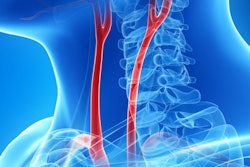
Can subclinical carotid atherosclerosis as identified on ultrasound negatively affect cognitive performance? Yes -- at least in individuals who carry a genotype known to increase the risk of developing Alzheimer's disease, according to research published in the July issue of Stroke.
Researchers from the University of Miami and Columbia University analyzed a subset of patients in the ongoing Northern Manhattan Study (NOMAS) of stroke in a multiethnic population. They found that participants who had higher levels of carotid intima-media thickness (CIMT) on ultrasound and who carried the ε4 version of the apolipoprotein E (APOE) genotype had worse episodic memory, semantic memory, and processing speed than those who did not have the genotype.
"APOE ε4 carriers with greater [CIMT] exhibited worse cognition across most domains, suggesting that subclinical vascular disease may exacerbate cognitive dysfunction in those who are at higher risk for Alzheimer disease," wrote lead author Hannah Gardener, ScD, of the University of Miami, and colleagues.
Predicting cognitive impairment
Ultrasound markers of carotid atherosclerosis -- carotid plaque burden and CIMT -- have been associated with various vascular risk factors and incident cardiovascular disease. Although cardiovascular disease has been previously associated with cognitive impairment, less is known about the ability of these carotid ultrasound markers to predict cognitive impairment, according to the authors (Stroke, July 2017, Vol. 48:7, pp. 1855-1861).
Previous research has found that CIMT and carotid plaque may be associated with cognitive impairment and dementia, suggesting that early intervention for carotid atherosclerosis may prevent cognitive impairment. These study results have been inconsistent, though, and more research needs to be performed in racially and ethnically diverse populations that have a higher cardiovascular disease burden than whites, the group wrote.
Gardener and colleagues hypothesized that greater carotid plaque burden and CIMT would be associated with domain-specific cognitive performance and decline in the racially and ethnically diverse NOMAS, an ongoing longitudinal cohort study of stroke in an urban population.
"Carotid atherosclerosis represents a potentially valuable target for early intervention and risk stratification for those at risk for cognitive decline," the authors wrote.
NOMAS
In this analysis, the researchers considered 1,166 NOMAS participants who had received a carotid ultrasound study and an initial neuropsychological examination, which included tests grouped into four cognitive domains: episodic memory, executive function, processing speed, and semantic memory. Of the 1,166 initial participants, 826 completed a second neuropsychological evaluation an average of five years later. The participants' second neuropsychological exam scores were subtracted from their first exam scores to determine changes in cognitive performance.
The participants, 60% of whom were women, had a mean age of 70. Hispanics comprised 66% of the study population, followed by non-Hispanic blacks (18%) and non-Hispanic whites (15%). Starting in 2000, all NOMAS participants received high-resolution B-mode ultrasound imaging at baseline by trained and certified sonographers on a Logiq 700 scanner (GE Healthcare) with a 9- to 13-MHz linear-array transducer, according to the researchers. Plaque burden and CIMT were measured as part of the ultrasound exam.
The researchers examined CIMT, carotid plaque presence, and carotid plaque area and correlated them with the neuropsychological exam scores. They also investigated whether age, race/ethnicity, and the APOE ε4 allele affected the findings.
Worse cognition
The researchers used beta (β) to represent the difference in exam scores between those who had higher CIMT and those who didn't, with the lower β-value representing a greater difference. Overall, participants with greater CIMT had worse episodic memory (β = -0.60, p = 0.04) at the first neuropsychological exam. Additional inverse associations between CIMT and initial assessments of semantic memory, executive function, and processing speed did not reach statistical significance.
However, that wasn't the case for the 24% of patients in the study who carried the APOE ε4 allele. After performing stratified analysis in comparison with neuropsychological exam scores from those who did not have the APOE ε4 allele, the researchers found that CIMT was inversely associated at the initial assessment with three of the four cognitive domain measures among APOE ε4 carriers, as represented by lower β scores among these individuals.
| Cognitive performance at baseline for APOE ε4 carriers with increased CIMT on ultrasound | ||
| β (difference between APOE ε4 carriers and noncarriers) | p-value | |
| Semantic memory scores | -1.451 | 0.01 |
| Episodic memory scores | -1.313 | 0.04 |
| Processing speed scores | -1.211 | 0.03 |
"Subclinical carotid atherosclerosis was associated with worse cognition among those at higher risk for Alzheimer disease," the authors wrote. "Interventions targeting early stages of atherosclerosis may modify cognitive aging."
No effect on cognitive decline
Those participants who had greater CIMT at baseline did not exhibit a significantly greater cognitive decline -- as determined by comparing the first and second neuropsychological exams -- than those who did not have elevated CIMT, the researchers noted. Among the various groups of patients, noncarriers of APOE ε4 with greater CIMT showed the most decline in executive function (β = -0.98) at the second neuropsychological exam, compared with the overall study population, although the lowered performance did not reach statistical significance (p = 0.06).
Notably, carotid plaque presence and burden were not found to be significantly associated with cognition at baseline or to be significant predictors of cognitive performance over time -- regardless of APOE ε4 allele status.
"None of the carotid atherosclerosis markers were significantly associated with cognitive decline after repeated [neuropsychological exams] an average of five years apart, and greater [CIMT] was associated with less decline in episodic memory, contradicting our initial hypothesis," the authors wrote.
However, the paradoxical finding that greater CIMT was associated a lower decline in episodic memory at the second neuropsychological exam may be explained by a healthy cohort effect in the study, according to the researchers.
"Participants who were available for a second [neuropsychological exam] are likely healthier than those who did not complete the second [neuropsychological exam]," they wrote. "Competing risk of mortality is also a concern in this older cohort."
Further studies should explore the mediating effects of the APOE ε4 allele on vascular wall changes and cognition, the group concluded.




















